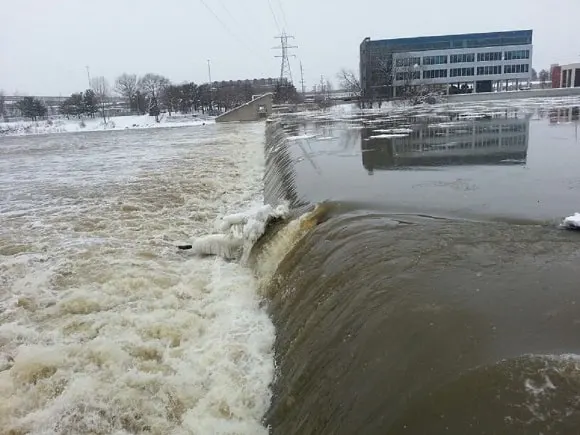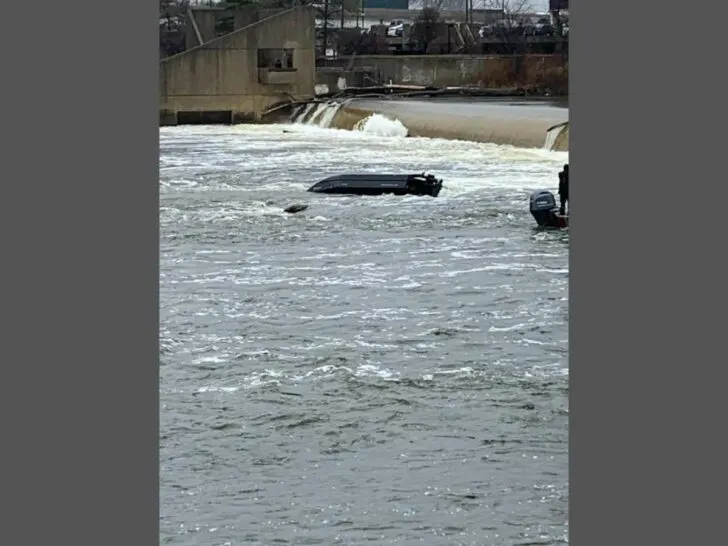Featured image courtesy of Kenny Darwin
In a scary incident that underscores the unpredictable nature of river fishing near low-head dams, three fishermen experienced a near-tragic event on Friday, March 8, when their boat capsized in the turbulent waters near the 6th Street Dam in downtown Grand Rapids.
This story not only highlights the inherent risks associated with fishing near such powerful structures but also showcases the incredible sense of community and quick action among fellow anglers.
The Incident Unfolds
It was an ordinary day turned extraordinary for three anglers who found themselves in peril when their fishing expedition took a dramatic turn.
The trio, who had ventured too close to the dam, found their boat overwhelmed by the water’s force, leading to a capsize into the rough waters.
The Grand Rapids Fire Department responded to the scene, suggesting that the boat’s proximity to the dam was a critical factor in the accident.
Heroic Anglers to the Rescue
The real heroes of this story were the nearby fishermen who didn’t hesitate to leap into action upon witnessing the distressing scene.
Demonstrating remarkable bravery and quick thinking, they navigated their boat to the three anglers, pulling them to safety.
Among the rescued, one man was found unconscious, not breathing and without a pulse.
In a life-saving gesture, CPR was administered as they made their way back to shore, thankfully resulting in the man regaining consciousness and beginning to talk.
According to news reports, the other two fishermen, while shaken, did not require medical attention.
A Lesson in Safety and Solidarity
This incident serves as a powerful reminder of the dangers that can lurk in the waters near dams, where the water’s power can easily catch even the most experienced anglers off guard.
It also highlights the incredible solidarity within the fishing community, where the welfare of fellow anglers is paramount, and individuals are ready to risk their own safety to help others in distress.
Makes one feel good, doesn’t it?
A Call to Caution
As sport anglers, we often seek the thrill of the catch, sometimes pushing the limits to hook that trophy fish. However, this incident is a stark reminder of the importance of respecting nature’s power and the need for caution when fishing near dams like 6th Street.
Always maintain a safe distance, be aware of water conditions, and never underestimate the currents!
If you need a visual example; this is how the trio’s boat looked after the incident. Pretty scary stuff right there:
The Hidden Dangers of Low-Head Dams

Low-head dams, often referred to as “drowning machines,” present a significant hazard to boats and anglers alike. This danger is not always apparent, especially to the inexperienced.
These structures can create deceptively dangerous conditions that have led to numerous accidents and fatalities over the years.
Understanding why these dams are so perilous is crucial for anyone engaging in activities on rivers and streams.
The Deceptive Calm Above
From upstream, low-head dams often appear harmless.
The water surface leading up to the dam can seem calm and navigable, misleading boaters and anglers into underestimating the danger.
This false sense of security can lead to boats getting too close to the dam, where the water’s pull becomes inescapable.
The Backroller: A Trap Below
The real danger of low-head dams lies at their base, where water flowing over the dam creates a strong recirculating current known as a “backroller” or “hydraulic jump.”
This turbulent water can trap objects, including boats and individuals, in a continuous cycle of being pulled under the water, pushed to the surface, and then sucked back again.
The force and unpredictability of this hydraulic make it extremely difficult for trapped individuals to escape, often leading to exhaustion and drowning.
The Underwater Turbulence
Below the surface, the water near a low-head dam is highly turbulent, filled with air, and creates conditions that significantly reduce buoyancy.
This makes swimming or floating to safety much more challenging, even for those wearing life jackets. The aerated water also affects the buoyancy of boats, making them more likely to capsize.
Visibility and Rescue Challenges
The turbulent waters of a low-head dam make it difficult for rescuers to see and reach anyone trapped in the back roller.
The chaos at the base of the dam also poses a significant risk to rescuers, making it a perilous environment for both victims and those attempting to help.
The Perilous Waters of 6th Street Dam: A History of Incidents
The 6th Street Dam in Grand Rapids has been the site of numerous fishing incidents over the years, highlighting the dangers that the dam presents to anglers and boaters alike.
Two notable incidents in recent years underscore the risks and the importance of exercising caution in this area.
March 2018 Incident
In March 2018, a dramatic scene unfolded as a fishing boat capsized in the dam’s turbulent waters.
The incident occurred late in the afternoon, with bystanders reporting that the boat became trapped in the churning waters near the dam.
All three individuals aboard managed to escape injury, though one was still inside the boat as it flipped.
Witnesses watched as the men swam away from the dangerous waters.
Grand Rapids firefighters evaluated the men post-rescue, finding them cold but uninjured.
October 2019 Incident
Another harrowing event took place in October 2019, when two fishermen found themselves in peril after their boat tipped over on the Grand River near the 6th Street dam.
The call for help came in around 10:29 a.m., prompting a swift response from local authorities.
Fortunately, other anglers in the vicinity acted quickly to pull the men from the water.
While neither suffered serious injuries, one of the individuals may have dislocated his shoulder.
Both were transported to a local hospital for evaluation.


Leave a comment